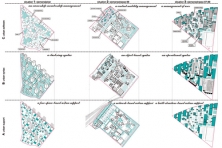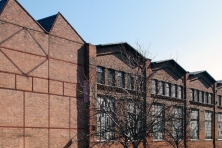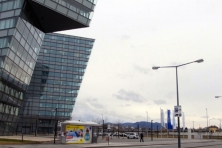Urban Software
Wien-Siemensäcker (AT) – Mentionné
DONNÉES DE L'ÉQUIPE
Représentant d'équipe : Enrique Arenas (ES) – architecte ; Associés : Luis Basabe (ES), Luis Palacios (ES) – architectes
Collaborateurs : Almudena Cano (ES) – architecte ; Paula Fernández (ES), Kerstin Pluch (AT), Ana Prieto (ES) – étudiantes en architecture
Plaza del Cordón, 28005 Madrid – España
+34 61 904 69 35 – enrique@arenasbasabepalacios.com – www.arenasbasabepalacios.com
Voir la liste complète des portraits ici
Voir la page du site ici
 L. Palacios, P. Fernández, K. Pluch, A. Cano, A. Prieto, L. Basabe et E. Arenas
L. Palacios, P. Fernández, K. Pluch, A. Cano, A. Prieto, L. Basabe et E. Arenas
INTERVIEW (en anglais)
1. How did you form the team for the competition?
Our team is the result of a longtime relationship between Arenas Basabe Palacios architecture office and ETSAM University in Madrid. Since its beginning, the studio has always collaborated with students from the partners’ teaching classes and has formed a solid working and research organization which keeps the studio running, not only engaging in international competitions but also in all kinds of projects.
2. How do you define the main issue of your project, insisting on how you answered on this session main topic: adaptability and urban rhythms?
The main topic we have developed in our proposal is the democratization of the city construction processes. Very close to Europan’s motto, we understand that urban adaptability has to find its basis in the participation of as many actors involved as possible, from government to individuals.

3. How did this issue and the questions raised by the site mutation meet?
In order to achieve this goal in a complex and diverse context as Siemensäcker, we were forced to design a set of tools that would boost every actor’s engagement. Three different situations were identified and three basic urban tools put to work. Their crossing creates a matrix of possibilities that need to be taken in consideration and chosen by a negotiation body that represents everyone’s interests. The architect’s role is turned into an intermediary that allows a real transversal participation and self-management of the city.


4. Have you already treated this issue previously and could you present some reference projects that inspired yours?
Our office has been working in the past years with similar strategies in urban (re)generative processes. The project that won Europan 9 in Badajoz (ES), was based in a matrix that stimulated participation in the district’s rehabilitation, and is currently underway.
On the other hand, we have worked on several collaborative urban-planning projects in Vienna that have inspired our way of understanding city production.
5. Today –within the era of an economic crisis and sustainability– the urban-architectural project should reconsider its production method in time; how did you integrate this issue in your project?
One of the advantages of Urban Software as a negotiation tool and a set of technical recommendations is that the construction of the city directly depends on the actor’s decision. Instead of proposing a closed urban design, it allows them to organize in time the production and development of their own district.
6. Is it the first time you have been awarded a prize at Europan? How could this help you in your professional career?
In this edition of Europan 12, our team has also been awarded a first prize on the project “Twinphenomena” for the Swedish site Höganäs. In the past editions, we have won three first prizes (Badajoz and Kapfenberg in Europan 9, and Vienna in Europan 10) and a runner-up prize in Alcázar de San Juan (Europan 8). Since we received these awards, our studio has obtained commissions from Badajoz and Vienna’s city councils and is still working on the realization of both first prizes. The projects that we have developed thanks to Europan have made possible the preservation and consolidation of our architecture firm.